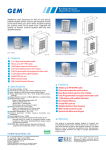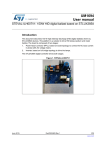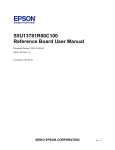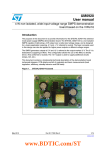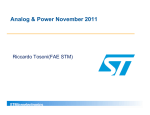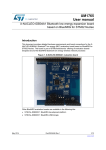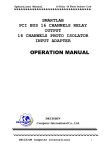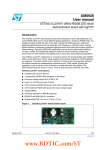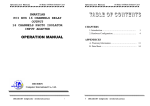Download STEVAL-ISA081V1 - STMicroelectronics
Transcript
UM0984 User manual STEVAL-ISA081V1 demonstration board based on a 12 V / 1 A isolated flyback Introduction The purpose of this document is to provide information on the STEVAL-ISA081V1 switched mode power supply (SMPS) demonstration board. The STEVAL-ISA081V1 is an isolated SMPS capable of delivering a 12 W output over a wide input voltage range. It is designed for a mains application focused on providing a cost-effective and space saving solution. The STEVAL-ISA081V1 SMPS generates 12 V nominal output voltage using primary regulation. This board is based on VIPer™26LD - a monolithic converter integrating a high voltage MOSFET and PWM controller in one package. This document contains a fundamental technical description of the demonstration board (schematic diagram, PCB details, and bill of materials) as well as basic measurements (load regulation, efficiency, standby behavior, EMI and thermal behavior data). The last section of this document contains short recommendations on how to set different output voltages in the range of 10 to 18 V and how to improve efficiency up to 86%. Figure 1. June 2012 Demonstration board STEVAL-ISA081V1 Doc ID 17812 Rev 2 1/25 www.st.com Contents UM0984 Contents 1 Main characteristics . . . . . . . . . . . . . . . . . . . . . . . . . . . . . . . . . . . . . . . . . 5 2 Board connection . . . . . . . . . . . . . . . . . . . . . . . . . . . . . . . . . . . . . . . . . . . 6 3 Board description . . . . . . . . . . . . . . . . . . . . . . . . . . . . . . . . . . . . . . . . . . . 7 4 5 6 2/25 3.1 Schematic . . . . . . . . . . . . . . . . . . . . . . . . . . . . . . . . . . . . . . . . . . . . . . . . . . 7 3.2 Description of main components . . . . . . . . . . . . . . . . . . . . . . . . . . . . . . . . 9 3.2.1 The input section contains . . . . . . . . . . . . . . . . . . . . . . . . . . . . . . . . . . . . 9 3.2.2 The flyback converter consists of . . . . . . . . . . . . . . . . . . . . . . . . . . . . . . . 9 3.3 Transformer . . . . . . . . . . . . . . . . . . . . . . . . . . . . . . . . . . . . . . . . . . . . . . . 10 3.4 Layout . . . . . . . . . . . . . . . . . . . . . . . . . . . . . . . . . . . . . . . . . . . . . . . . . . . . 11 3.5 BOM . . . . . . . . . . . . . . . . . . . . . . . . . . . . . . . . . . . . . . . . . . . . . . . . . . . . . 13 Measurements . . . . . . . . . . . . . . . . . . . . . . . . . . . . . . . . . . . . . . . . . . . . . 15 4.1 Efficiency . . . . . . . . . . . . . . . . . . . . . . . . . . . . . . . . . . . . . . . . . . . . . . . . . 15 4.2 Standby . . . . . . . . . . . . . . . . . . . . . . . . . . . . . . . . . . . . . . . . . . . . . . . . . . 17 4.3 Load regulation . . . . . . . . . . . . . . . . . . . . . . . . . . . . . . . . . . . . . . . . . . . . 18 4.4 EMI . . . . . . . . . . . . . . . . . . . . . . . . . . . . . . . . . . . . . . . . . . . . . . . . . . . . . . 20 4.5 Temperature . . . . . . . . . . . . . . . . . . . . . . . . . . . . . . . . . . . . . . . . . . . . . . . 21 Application recommendations . . . . . . . . . . . . . . . . . . . . . . . . . . . . . . . . 22 5.1 Output voltage operating range . . . . . . . . . . . . . . . . . . . . . . . . . . . . . . . . 22 5.2 Improved efficiency . . . . . . . . . . . . . . . . . . . . . . . . . . . . . . . . . . . . . . . . . 23 Revision history . . . . . . . . . . . . . . . . . . . . . . . . . . . . . . . . . . . . . . . . . . . 24 Doc ID 17812 Rev 2 Document alternate name List of tables List of tables Table 1. Table 2. Table 3. Table 4. Table 5. Transformer windings . . . . . . . . . . . . . . . . . . . . . . . . . . . . . . . . . . . . . . . . . . . . . . . . . Bill of materials . . . . . . . . . . . . . . . . . . . . . . . . . . . . . . . . . . . . . . . . . . . . . . . . . . . . . . Settings and performance of demonstration board for different output voltages . . . . Efficiency using a 60 V Schottky diode . . . . . . . . . . . . . . . . . . . . . . . . . . . . . . . . . . . . Document revision history . . . . . . . . . . . . . . . . . . . . . . . . . . . . . . . . . . . . . . . . . . . . . Doc ID 17812 Rev 2 . . . . 10 . . . . 13 . . . . 22 . . . . 23 . . . . 24 3/25 List of figures UM0984 List of figures Figure 1. Figure 2. Figure 3. Figure 4. Figure 5. Figure 6. Figure 7. Figure 8. Figure 9. Figure 10. Figure 11. Figure 12. Figure 13. Figure 14. 4/25 Demonstration board STEVAL-ISA081V1 . . . . . . . . . . . . . . . . . . . . . . . . . . . . . . . . . Input/output connection of SMPS . . . . . . . . . . . . . . . . . . . . . . . . . . . . . . . . . . . . . . . . STEVAL-ISA081V1 circuit schematic . . . . . . . . . . . . . . . . . . . . . . . . . . . . . . . . . . . . . Transformer construction . . . . . . . . . . . . . . . . . . . . . . . . . . . . . . . . . . . . . . . . . . . . . . PCB layout - from top side TOP, BOT SMD, BOT copper . . . . . . . . . . . . . . . . . . . . . Efficiency at 120 VAC and 230 VAC vs. output current . . . . . . . . . . . . . . . . . . . . . . . Efficiency at full load (1 A) vs. input voltage . . . . . . . . . . . . . . . . . . . . . . . . . . . . . . . . Standby power vs. input voltage . . . . . . . . . . . . . . . . . . . . . . . . . . . . . . . . . . . . . . . . . 12 V output load regulation . . . . . . . . . . . . . . . . . . . . . . . . . . . . . . . . . . . . . . . . . . . . . 3.3 V output load regulation . . . . . . . . . . . . . . . . . . . . . . . . . . . . . . . . . . . . . . . . . . . . Output voltage at no load vs. the input voltage level . . . . . . . . . . . . . . . . . . . . . . . . . EMI measurement regarding EN55022 Class 2 - left peak detector, right AVG detector . . . . . . . . . . . . . . . . . . . . . . . . . . . . . . . . . . . . . . . . . . . . . . . . . . . Thermal map of the board at 305 V AC on the input - left bottom side, right top side Thermal map of the board at 85 V AC on the input - left bottom side, right top side . Doc ID 17812 Rev 2 .....1 .....6 .....8 . . . . 11 . . . . 12 . . . . 15 . . . . 16 . . . . 17 . . . . 18 . . . . 19 . . . . 19 . . . . 20 . . . . 21 . . . . 21 UM0984 1 Main characteristics Main characteristics The main characteristics of the SMPS are listed below ● ● Input: – VIN: 85 ~ 305 Vrms – frequency: 45 ~ 66 Hz Output: – 12 VDC ± 10%, 1 A (at 3.3 V not loaded) – 3.3 VDC ± 4%, 100 mA – Maximum total output current of 1 A ● Standby < 120 mW at 230 VAC ● Short-circuit: protected ● PCB type and size: – FR4 – Single-sided 35 µm – 32 x 90 mm ● Isolation: isolated 4 kV / 8 mm ● EMI: according to EN55022 Class B Doc ID 17812 Rev 2 5/25 Board connection 2 UM0984 Board connection The STEVAL-ISA081V1 demonstration board is shown in Figure 2 below, with input and output locations. Figure 2. 6/25 Input/output connection of SMPS Doc ID 17812 Rev 2 UM0984 Board description 3 Board description 3.1 Schematic A schematic diagram of the isolated flyback converter board prototype based on the VIPER26LD is provided in Figure 3 on page 8. Doc ID 17812 Rev 2 7/25 8/25 * # N&8 2 n Doc ID 17812 Rev 2 6 6 2 $ 344(2! 2 2 P& 6 # # 6 N& # 2 2 .! &" 6$$ .# '.$ '.$ ,)- #/-0 )# $ 6IPER,$ . $2!). $2!). $2!). $2!). 6 # # 6 2OPT N& # N& # 2 N& 6 # $ 3403( # P& #OPT 2 .! 42 %& N&9 ' ' ' ' # N& )# ,,!# 6 ). 6/54 '.$ !-6 * 6 6 Figure 3. 66 $" "3 , XM( # Board description UM0984 STEVAL-ISA081V1 circuit schematic UM0984 3.2 Board description Description of main components The complete converter application consists of an input section and the flyback converter itself. 3.2.1 The input section contains Bridge diode rectifier (DB1) The bridge diode rectifier is used to reduce the size of the input bulk capacitor. Inrush current limiter (R1) This component reduces the inrush current caused by the connection of the SMPS to the mains (charging current of bulk capacitors) or by surge pulses. It is recommended to use a wirewound resistor to get higher immunity against current spikes. EMI filter (L1, C1, C2, C13) This basic EMI pi-filter uses an X2 foil capacitor (C1), bulk capacitors (C2, C13) and a CMC inductor (L1). Input bulk capacitors (C2, C13) These capacitors store energy when the input AC voltage is low. Their value respects the minimum input voltage and output power. The maximum voltage of these capacitors is 450 V for this design because the maximum input voltage is specified up to 305 VAC. If the maximum input voltage of the application is lower (more often the value is 265 VAC), 400 V capacitors can be used. 3.2.2 The flyback converter consists of VIPER26LD (IC1) This device integrates a controller and high voltage power MOSFET in one package. The controller works in current mode with a fixed frequency and in discontinuous mode even at the lowest input voltage. Thanks to the built-in error amplifier, the VIPER26LD can directly sense the auxiliary voltage via a voltage divider (R5, R6). Thanks to good coupling of the auxiliary and secondary windings, the auxiliary voltage corresponds well with the secondary voltage and can be used for feedback regulation. Mandatory components for proper operation of the VIPer26 are VDD capacitor C4 and compensation network R8, C6 and C7. Diode D2 provides auxiliary voltage to C4 and the feedback voltage divider. Note: The voltage divider collecting feedback information for the FB pin is connected to the VDD pin. The total resistance of this voltage divider has to be designed with respect to the minimum charging current during startup and additional possible leakage currents (VDD capacitor). The minimum charging current is 600 µA, the maximum leakage current through the VDD capacitor can be theoretically in the range of several tens of µA. The total current through the voltage divider is therefore set to 150 µA to guarantee enough margin for the startup circuit. Doc ID 17812 Rev 2 9/25 Board description UM0984 Peak clamp (D1, R2, R3, C3) This circuit absorbs energy from the voltage spike present after MOSFET turn-off. This spike is generated by leakage inductance of the transformer. Alternatively, a Transil™based peak clamp can be used - for instance PKC-136. The application of this device allows reducing standby consumption and it can also save some space on the board. Secondary side (D3, C8, C11, R9, C9, IC2, C10) The main secondary part is a rectifier consisting of D3 and C8. The C8 capacitor is stressed by a high level peak current and therefore a low ESR capacitor is used. The snubber circuit (optional) of D3 consists of C11 and R9. Thanks to the primary regulation, no additional components are required. A simple linear regulator to generate 3.3 V on the output can also be implemented. The regulator (IC2) plays also the role of a bleeder - partly loading the output and keeping the output voltage below limits at no load. In case IC2 is not assembled, some type of bleeder (either a Zener diode or resistor) has to be applied in order to limit the maximum output voltage at no load. Note: Components C13, DB1 and D3 appear with a suffix “A” on the PCB. This signifies that there is an assembled alternative package on the board. The functionality of such a component is the same as the basic component and therefore these components are not indicated in the schematic visible in Figure 3. 3.3 Transformer The transformer construction is designed in order to get good coupling between the auxiliary and secondary to reach applicable load regulation even when the primary regulation is used. The transformer was developed in cooperation with WÜRTH ELEKTRONIK company and is available under order number 760871131. The transformer specifications are as follows: ● E20/10/6 - 60 kHz, voltage range 85 - 305 VAC ● Core shape E20/10/6 ● Core Al 150 nH ● Primary to secondary isolation 4 kV AC Table 1. 10/25 Transformer windings Wire Wire Inductance Number Wire diameter material (µH) of turns number (mm) Layer Start pin Stop pin 1 3 1 96 2 0.2 Cu2l 1394 Primary 2 7, 8, 9, 10 11, 12, 13, 14 10 4 0.3 TeX 15 12 V / 1 A 3 6 5 12 1 0.2 Cu2l 22 14.5 V / aux. Doc ID 17812 Rev 2 Position UM0984 Board description Figure 4. 3.4 Transformer construction Layout The layout of the PCB is based on a single-sided FR4, with 35 µm thickness. The size of the PCB is 32 x 90 mm. The distance between the primary and secondary side is higher than 8 mm, respecting the safety requirements for all standard applications. The layout of the PCB is provided in Figure 5. The layout was designed with respect to the following rules to achieve stable operation, good efficiency and reduce EMI noise. ● The power HF tracks are wide and short: – Transformer to IC1 – Transformer to C13 – IC1 to C13 – Transformer to C8 – C8 to D3 – Transformer to D3 – Peak clamp loop ● The power and signal GND of VIPER26LD are separated and connected only in one point close to the source pins ● The EMI filter has been placed far from the transformer to avoid possible crosstalk of EMI noise Doc ID 17812 Rev 2 11/25 Board description Figure 5. 12/25 UM0984 PCB layout - from top side TOP, BOT SMD, BOT copper Doc ID 17812 Rev 2 UM0984 Board description 3.5 BOM Table 2. Bill of materials Index Quantity Ref. Value / generic part number 1 1 R1 5.1 Ω / 2 W Wirewound 4.7 Ω / 2 W Wirewound 51 kΩ / 5% / 0.25 W 1206 or Package / class 2 2 R2, R3 3 1 R4 3.9 Ω / 5% / 0.1 W 0805 4 1 R5 150 kΩ /1% / 0.1 W 0805 5 1 R6 43 kΩ / 1% / 0.1 W 0805 6 0 R7 Not assembled 7 1 R8 10 kΩ / 5% / 0.1 W 8 0 R9 Not assembled 9 1 C1 100 nF / 305 VAC / X2 18 x 5 x 11 RM 15 10 1 C2 10 µF / 450 V D12.5 x 20 RM 5 11 1 C3 470 pF / 200 V 1206 12 1 C4 10 µF / 35 V / 105 °C D5 x 11 RM 2 13 1 C5 2.2 nF / 50 V 0805 14 1 C6 1 nF / 50 V 0805 15 2 C7, C10 100 nF / 50 V 0805 16 1 C8 470 µF / 35 V / low ESR D10 x 20 RM 5 17 1 C9 330 nF / 50 V 0805 18 0 C11 Not assembled 19 1 C12 1 nF / 250 VAC / 4 kV / Y1 20 0 C13 Not assembled 21 1 C13A 22 1 23 Manufacturer 0805 EPCOS RM 12 22 µF / 450 V D16 x 20 RM 5 L1 CMC 2 x 10 mH UU9.8, RM 8 x 7 EPCOS 1 T1 EF20 - 1.41 mH EF20 WÜRTH ELEKTRONIK 24 0 DB1 Not assembled 25 1 DB1A 26 1 27 1 A / 800 V / bridge SO-DIL D1 STTH1R06A SMA 1 D2 1N4148 MINIMELF / SOD80 28 0 D3 Not assembled 29 1 D3A STPS2H100U SMB STMicroelectronics 30 1 IC1 VIPER26LN SO16N STMicroelectronics 31 1 IC2 L78L33AC SO8N STMicroelectronics Doc ID 17812 Rev 2 STMicroelectronics™ 13/25 Board description Table 2. UM0984 Bill of materials (continued) Index Quantity Ref. 32 1 J1 Screw terminal 2 pos. RM 5 mm 33 1 J2 Screw terminal 3 pos. RM 5 mm 14/25 Value / generic part number Package / class Doc ID 17812 Rev 2 Manufacturer UM0984 Measurements 4 Measurements 4.1 Efficiency Figure 6. Efficiency at 120 VAC and 230 VAC vs. output current Doc ID 17812 Rev 2 15/25 Measurements Figure 7. UM0984 Efficiency at full load (1 A) vs. input voltage The output voltage efficiency depending on the output current of the 12 V output is displayed in Figure 6. The 3.3 V output was not loaded for this measurement. Figure 7 shows the efficiency of the SMPS at full load applied on the 12 V output (1 A, 3.3 V output not loaded) depending on the different input voltages. A drop of efficiency at low input voltage is mainly caused by an increase of the losses of the input inrush resistor and CMC. The efficiency was calculated as the ratio between the output power and input power. The input power was directly measured by power analyzer NORMA 4000. The output power was calculated as the product of the output current and output voltage. The output voltage was measured on the output connector by multimeter KEITHLEY 2000 and the current was measured by multimeter FLUKE 189. 16/25 Doc ID 17812 Rev 2 UM0984 Measurements 4.2 Standby Figure 8. Standby power vs. input voltage The standby behavior of the board is displayed in Figure 8. The blue line is the standby input power of the fully assembled board. The red line is the standby input power of the board without linear regulator L78L33 and with a 15 V Zener diode applied as a bleeder. The typical input current of L78L33 is 3.5 mA which is approximately 40 mW of load present on the secondary side. The standby input power was directly measured by power analyzer NORMA 4000. The output connection was kept open during the measurement. Doc ID 17812 Rev 2 17/25 Measurements 4.3 Load regulation Figure 9. 12 V output load regulation UM0984 The load regulation of the 12 V output is displayed in Figure 9. The output voltage at no output load is determined by the consumption of L78L33. If L78L33 is not implemented and no other bleeder (Zener diode or resistor) is used, the output voltage rises. The load regulation of the 3.3 V output is visible in Figure 10. 18/25 Doc ID 17812 Rev 2 UM0984 Measurements Figure 10. 3.3 V output load regulation The output voltage of the 3.3 V and 12 V output at no load depending on the input voltage is visible in Figure 11. Figure 11. Output voltage at no load vs. the input voltage level Doc ID 17812 Rev 2 19/25 Measurements 4.4 UM0984 EMI The conductive EMI test of the demonstration board is displayed in Figure 12. The AVG detector is indicated on the left, the peak detector measurement is indicated on the right. Figure 12. EMI measurement regarding EN55022 Class 2 - left peak detector, right AVG detector 20/25 Doc ID 17812 Rev 2 UM0984 4.5 Measurements Temperature The thermal map at full load, measured at 305 VAC and at 85 VAC, is displayed in Figure 13 and Figure 14. The ambient temperature was 25 °C. Figure 13. Thermal map of the board at 305 V AC on the input - left bottom side, right top side Figure 14. Thermal map of the board at 85 V AC on the input - left bottom side, right top side Doc ID 17812 Rev 2 21/25 Application recommendations UM0984 5 Application recommendations 5.1 Output voltage operating range The demonstration board STEVAL-ISA081V1 was originally designed for output specification 12 V / 1 A supplied from wide input range 85 to 305 VAC. With minimal changes of components it is possible to set a different output voltage in the nominal output voltage range of 10 to 18 V, keeping the output power capability. The only changes are in the values of voltage divider R5, R6. The other components including the transformer remain the same. Table 3 shows applicable values of the voltage divider for different nominal output voltages. There is also visible an indicative value of output voltage at full and no load, standby consumption and efficiency at full load measured on one sample. Table 3. Settings and performance of demonstration board for different output voltages VOUT (V) nominal value R5 (kΩ) R6 (kΩ) VOUT (V) VOUT(V) IOUT (A) VAUX (V) no load full load at load PIN (mW) Eff. (%) no load 10 150 56 10.90 9.70 1.20 12.2 100 83.0 12 150 43 13.10 11.80 1.00 15.0 112 84.1 15 150 33 15.90 14.75 0.80 18.6 170 83.9 18 91 16 18.90 17.80 0.67 21.8 270 83.7 The major limitation regarding the setting of the output voltages is the VIPer26 supply range (VAUX column) and transformer design. The supply voltage of VIPer26 has to be in the range of 11.5 to 23.5 V which consequently limits the output voltage range using the same transformer. There are theoretically several possible limiting factors caused by the transformer due primarily to the turns ratio. The consequence of using a transformer designed for 10 V output for an 18 V output voltage level is a higher voltage stress on the primary side switch. Thanks to the VIPer26 which has implemented an 800 V MOSFET, there is still enough margin even at 18 V on the output. The maximum drain source voltage measured at 305 VAC with 18 V set on the output was 700 V. 22/25 Doc ID 17812 Rev 2 UM0984 5.2 Application recommendations Improved efficiency The measured efficiency is about 84% at full output load and 230 VAC. This value can be increased by simply changing the output Schottky diode. Please note that the original board contains an STPS3H100 - 3 A / 100 V Schottky diode. This diode is universal - applicable also up to 18 V output voltage. If only 12 V output is required, a 60 V Schottky diode can be used. An STPS5L60 - 5 A / 60 V Schottky diode in the SMC package was tested. The result measured on one sample at 230 VAC is displayed in Table 4. Table 4. Efficiency using a 60 V Schottky diode D3 VOUT (V) full load IOUT (A) full load Eff. (%) VD3 (V) at 305 VAC STPS3H100 11.80 1.00 84.1 56 STPS5L60 12.15 1.00 86.1 56 Doc ID 17812 Rev 2 23/25 Revision history 6 UM0984 Revision history Table 5. 24/25 Document revision history Date Revision Changes 25-Nov-2010 1 Initial release. 08-Jun-2012 2 Updated Figure 3, minor text corrections throughout document. Doc ID 17812 Rev 2 UM0984 Please Read Carefully: Information in this document is provided solely in connection with ST products. STMicroelectronics NV and its subsidiaries (“ST”) reserve the right to make changes, corrections, modifications or improvements, to this document, and the products and services described herein at any time, without notice. All ST products are sold pursuant to ST’s terms and conditions of sale. Purchasers are solely responsible for the choice, selection and use of the ST products and services described herein, and ST assumes no liability whatsoever relating to the choice, selection or use of the ST products and services described herein. No license, express or implied, by estoppel or otherwise, to any intellectual property rights is granted under this document. If any part of this document refers to any third party products or services it shall not be deemed a license grant by ST for the use of such third party products or services, or any intellectual property contained therein or considered as a warranty covering the use in any manner whatsoever of such third party products or services or any intellectual property contained therein. UNLESS OTHERWISE SET FORTH IN ST’S TERMS AND CONDITIONS OF SALE ST DISCLAIMS ANY EXPRESS OR IMPLIED WARRANTY WITH RESPECT TO THE USE AND/OR SALE OF ST PRODUCTS INCLUDING WITHOUT LIMITATION IMPLIED WARRANTIES OF MERCHANTABILITY, FITNESS FOR A PARTICULAR PURPOSE (AND THEIR EQUIVALENTS UNDER THE LAWS OF ANY JURISDICTION), OR INFRINGEMENT OF ANY PATENT, COPYRIGHT OR OTHER INTELLECTUAL PROPERTY RIGHT. UNLESS EXPRESSLY APPROVED IN WRITING BY TWO AUTHORIZED ST REPRESENTATIVES, ST PRODUCTS ARE NOT RECOMMENDED, AUTHORIZED OR WARRANTED FOR USE IN MILITARY, AIR CRAFT, SPACE, LIFE SAVING, OR LIFE SUSTAINING APPLICATIONS, NOR IN PRODUCTS OR SYSTEMS WHERE FAILURE OR MALFUNCTION MAY RESULT IN PERSONAL INJURY, DEATH, OR SEVERE PROPERTY OR ENVIRONMENTAL DAMAGE. ST PRODUCTS WHICH ARE NOT SPECIFIED AS "AUTOMOTIVE GRADE" MAY ONLY BE USED IN AUTOMOTIVE APPLICATIONS AT USER’S OWN RISK. Resale of ST products with provisions different from the statements and/or technical features set forth in this document shall immediately void any warranty granted by ST for the ST product or service described herein and shall not create or extend in any manner whatsoever, any liability of ST. ST and the ST logo are trademarks or registered trademarks of ST in various countries. Information in this document supersedes and replaces all information previously supplied. The ST logo is a registered trademark of STMicroelectronics. All other names are the property of their respective owners. © 2012 STMicroelectronics - All rights reserved STMicroelectronics group of companies Australia - Belgium - Brazil - Canada - China - Czech Republic - Finland - France - Germany - Hong Kong - India - Israel - Italy - Japan Malaysia - Malta - Morocco - Philippines - Singapore - Spain - Sweden - Switzerland - United Kingdom - United States of America www.st.com Doc ID 17812 Rev 2 25/25

























